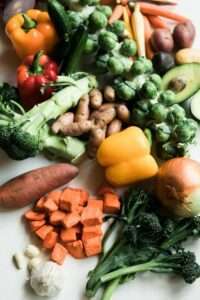 A new survey reports that people in the United States say they’re eating fruits and vegetables every day.
A new survey reports that people in the United States say they’re eating fruits and vegetables every day.
Some experts, however, say the survey respondents may be counting items such as french fries as vegetables.
They also note that the way vegetables are cooked makes a difference in their nutritional value.
They tell consumers to buy fruits and vegetables fresh when they’ll use them immediately and to purchase canned and frozen items for longer shelf life.
Nearly everybody over the age of 20 in the United States says they are eating some vegetables and two-thirds say they’re eating fruit on a daily basis.
That’s according to a new data releaseTrusted Source from the Centers for Disease Control and Prevention’s (CDC) National Center for Health Statistics.
The survey findings from 2015 to 2018 suggest daily fruit consumption is down compared to 20 years ago.
While vegetable intake has remained unchanged, there is a caveat. The percentage of adults who consumed dark green, red and orange, other vegetables, and any vegetable types on a given day increased with income.
On the whole, nutrition experts caution against using these findings in making population-wide dietary pattern conclusions.
What experts have to say
“I was an adjunct nutrition college professor for 15 years and I can tell you firsthand that I would take this data/report with a grain of salt, and a very large one,” says David Lightsey, MS, a food and nutrition science advisor and the author of “The Myths About Nutrition Science.”
“The data is based on 24-hour dietary recall. In other words, it is self-reported. This type of data is highly inaccurate because most individuals will misrepresent what they consume, which is pointed out by the authors themselves on pages 6 and 7,” Lightsey told Healthline.
“I believe it is naive for the authors of this study to use a 24-hour dietary recall, even if it were accurate, and extrapolate it to represent a dietary pattern for an extended period. They simply do not have enough observed information to do so,” he added.
Lightsey has seen this kind of inaccuracy in action.
“Part of my course always included two diet histories from my students,” he said. “The first required them to simply recall a 3-day dietary history while sitting in class. The second required a 3-day diet history involving recording what they ate as those days transpired.”
“Rarely would the recall diet history match the actual diet as it transpired over the course of 3 days,” Lightsey said.
“The dietary recall data normally over-reported the intake of both fruit and vegetables. Students would normally admit that they were embarrassed to report how they ate,” he explained.
Another issue arises when considering the lack of distinction in the data regarding cooking methods.
For example, it isn’t clear whether people included french fries as a vegetable.
Kristin Kirkpatrick, MS, RDN, the author of “Skinny Liver,” says it would explain a lot if that were the case.
“But I would not consider deep-fried vegetables like french fries as a vegetable in your daily measurements,” she said.
“I think when we communicate to people about the importance of fruits and vegetable consumption, we need to educate them on cooking methods and types as well,” she told Healthline.
“The nutrient content of vegetables changes depending on the cooking technique. Some methods cause nutrient loss and some methods cause nutrient gain,” said Caroline West Passerrello, MS, RDN, LDN, a spokesperson for the Academy of Nutrition and Dietetics.
“Deep-fried vegetables are often cooked with significant quantities of fat that are not present in other cooking techniques. Vegetables prepared in this way should be consumed in moderation to maintain a balanced diet and lifestyle,” Passerrello told Healthline.
What you need to know
The American Heart Association has long associated consuming a variety of colorful fruits and vegetables with disease prevention.
“All fruits and vegetables contain vitamins, minerals, and other nutrients that may help prevent heart disease, cancer, and other illnesses,” says the American Heart Association website. “Some of these nutrients are fiber, potassium, folate, and vitamins A and C.”
You can check to see if you’re getting enough nutrients by reading the Dietary Guidelines for Americans (2015-2020).
The guidelines state that a healthy eating pattern includes fruit, especially whole fruit, and a variety of vegetables from all of the subgroups — dark green, red and orange, legumes (beans and peas), starchy, and other categories.
Passerrello said that while individual consumption varies over time, what remains steady is how important fruits and vegetables are to health.
“Knowing something and being able to act on it are two different issues, and that knowledge isn’t captured in this [NCHS] data,” she said.
Lightsey says there are shades of gray that exist when it comes to talking about fruit and vegetable consumption.
“There are no magically healthy foods nor are they any inherently bad foods,” he said.
“Here is a question I would ask the parents in my course: You have a young child who refuses to eat any specific vegetable unless it is fried,” Lightsey said. “Is it better for the child to consume the fried vegetable and obtain the benefits of all the heat-stable nutrients and phytochemicals available in the vegetable, or not eat the vegetable at all and obtain zero benefits?”
Can COVID-19 lockdowns help our diets?
While some may think COVID-19 lockdowns offer an opportunity for families to focus on their fruit and vegetable intake, the reality is playing out differently across different households.
“Diet and intake fluctuate daily for many Americans due to budgets, time constraints, and preferences, to name a few factors,” said Passerrello.
“The pandemic has affected families in a variety of ways. Some have more time to cook, others find themselves with less time to focus on anything but their basic needs, while even more face food insecurity,” she said.
Passerrello points to a December survey collected by the International Food Information Council that found an increasing number of people are paying greater attention to the healthfulness of the food they’re buying.
“While these health-conscious numbers have increased throughout the year, 1 in 5 are worried about providing enough food for their family,” she said.
Kirkpatrick adds that the lockdowns could actually have a negative impact on fruit and vegetable intake.
“People are perhaps not at the store as much because they are staying home so fresh food may not be as readily available or they are eating out more,” she said.
Tips for eating more fruits and vegetables
Whether or not COVID-19 has impacted your household grocery budget, you should know there are cost-friendly ways to increase your daily consumption of fruits and vegetables.
Kirkpatrick recommends choosing frozen over fresh.
“I love frozen and think there is a fallacy in many minds that the frozen option is not as good,” she said. “The data, in fact, shows that frozen options can be more nutrient-dense since they are frozen at peak ripeness which retains all the nutrients.”
“Fresh, on the other hand, loses nutrients every day off the vine, tree, etc., as it travels to the point of purchase. For example, a person on the East Coast eating a fresh blueberry may be eating one that took a week just to get to their store from South America or warmer regions of the United States,” Kirkpatrick said.
Frozen options also last longer and do not run the risk of spoiling before you get a chance to eat them.
Passerrello agrees, adding canned and dried versions of fruits and vegetables to the list.
“These are good alternatives that are often more cost effective and accessible,” she said. “Just look for single-ingredient items whenever possible (i.e., the ingredient list is only the fruit or veggie, not with added sugar or sodium).”
“Check the labels on frozen, canned, and dried versions to see which is the best fit for your diet and lifestyle,” she added. “Another way to be cost conscious with fruits and veggies is planning ahead to use what you have and eliminate waste. Proper storage and a plan for how you will use your produce are key.”
Passerrello offers these other tips:
Have some go-to back up plans for when you realize the fruit or vegetables must be used immediately.
Freeze vegetables to make broth at a future date.
Use overripe fruits in baked goods.
Peel and freeze overripe fruits for use in smoothies.
Finally, keeping things in perspective is also important.
“Fresh produce is not expensive in comparison to the dietary choices made by most people,” Lightsey said.
Written by Michelle Pugle on February 9, 2021 — Fact checked by Maria Gifford
www.healthline.com




